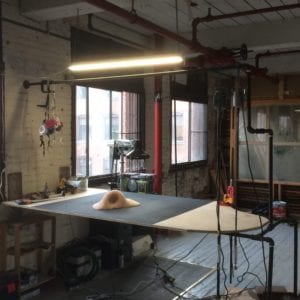The Decoy Board: World’s Newest Standard Board
Dan Yagmin's Decoy Board will become a kick-boardless standard training wall. With perfect polyurethane symmetry, it will be unique

Decoy Holds sets sail in a world of giants. Although the Connecticut-based grip company develops the most detailed holds on offer, only some will have heard of this developing business. This is about change.

For shaping fanatics, Decoy’s Dan Yagmin has become famous for his approach to hold design. Taking saws and sanders, Yagmin allows the foam to break along its natural fissure plains. He has created numerous unique shapes for both Decoy and Pusher.
Unlike some shapers, Yagmin’s original relationship with creative design came from a history in the arts. With an MFA in Illustration, his detail-oriented approach has come to describe Decoy’s hold designs.
“In the beginning, it was super experimental. I just tried different things. I would beat up the foam with a rock, cut the foam with a saw, just to see how it works.”
As Yagmin became more experienced, he would meld his illustrations with the highly featured shapes of the outdoors. He would create rock-influenced grip designs. Taking in the natural features of the rock, Yagmin would watch the stone taper and bulge into the unique shapes he had come to admire.
Although these shapes set Yagmin apart, Decoy has come to define itself along the cutting edge of hold design. While some shapers remain stuck in the past, Decoy looks toward technology to reimagine the design process.
This has meant incorporating the use of scanning, 3D-printing, virtual modelling and more. That is why many of Decoy’s shapes, although influenced by the outdoors, do not always reflect the rock exactly.
Decoy’s limestone line describes this principle. “When I think about limestone climbing, I think about how complex this rock type is. How hard it is to read, how varied and unpredictable the shapes are. In my opinion it is the hardest type of rock to on-sight climb on because the features are so unpredictable and polished. Many of the larger features you would expect to be footholds end up not being due to their sloping and often polished nature. Many of the pockets that appear to be juggy from the ground might not end up being so. Oftentimes better pockets hide within them that might be missed upon first inspection. It is this nuance and unpredictability that I hope to achieve in this line.
“For the Limestone line, I went heavy on the dual-tex. With its implementation, I hope to force the technical footwork that limestone climbing often demands. The hold shapes are focused on nuanced pockets, blobs, and tufas that all offer a lightly pock-marked texture.
“As with most rock textured holds that I create, I am looking to bring the ideas and elements of design that nature has produced on its own to the grips that I create. I am not interested in trying to copy the stone to its exact detail, as I think in most cases this will result in uncomfortable textures and shapes. It is more the ideas presented by a rock type, along with the feeling of what it is like to climb on it, that I am interested in capturing in my rock textured lines.”
Given this level of detail, a person might think that Decoy would make for an expensive option. This is not the case.
Yagmin remembers the process of buying holds. “Coming from a route setting background, I put myself in the buyer’s shoes a lot. Commercial gyms, even though a lot of them are very successful and making a lot of money, need to get as many holds as they can. I just try and keep that in mind and try and keep things as reasonable as I can.”
With the rising cost of materials, this becomes increasingly difficult, still, Yagmin wants people with home walls to have access to his high-quality shapes. Back in the day, Yagmin and his buddies would train together on a 45-degree wall. For Yagmin, board climbing made training enjoyable.
Quality grips can turn a tweaky woodie into an efficient training instrument. His attraction to board climbing runs so deep that he even decided to enter the exclusive market of standardized training boards.
Between Moon, Kilter and Tension, standardized boards have become popular. Still, moving into this industry is difficult.
The main reason for this comes from the variety of boards already on offer. Each MoonBoard tackles a slightly different climbing style, while the Tension Board’s wooden symmetry offers a clinical approach to climbing training. Kilter has gone in favour of high quality for a high cost, boasting more grips, surface area, and angles than either of these preceding companies. What remains for Decoy?
Yagmin has described the Decoy Board in terms of accessibility. Newer climbers will note that the MoonBoard does not make things easy. To that effect, the Kilter Board and the Tension Board do feature easier problems, but their costs make them difficult for individuals to access.
The Decoy Board tackles this problem in two unique ways. The first comes from the modularity of the grips on offer. Although the board will come with a standard hold set, climbers will be able to buy expansion packs to tailor the board to the user. This means that climbers or gyms can purchase packs that allow for newer climbers to access the board.
Does this mean the board is for beginners? Not even slightly. Long-term home wall users will smile knowing the Decoy Board will not feature a kick board. The kick board generally features a climbing wall’s most significant footholds. The problem with it comes from the fact that it does not reflect rock climbing.
Although there do exist boulder problems that feature a kickboard-like set of footholds, more often than not, rock breaks along fissure plains. This means that everything exists within the same angle. The Decoy Board removes the kickboard to reflect the real rock of outdoor climbing.
Yagmin also believes it will better the climbing experience. “I really don’t like the nature of a lot of board problems where you’re riding the kicker as long as you can, and then you jump from it. A lot of them start to feel the same. Launch and then jack your feet up into your face.”
Shorter climbers will know the sadness of watching their tall friends ride the kicker up to rows 10 and 11 on the MoonBoard. By contrast, taller climbers lose out on every boulder problem’s training potential due to the fact that they can ride the kicker.
As utilizing footholds in the angle makes the climbing more involved, the training potential is higher. The perfect symmetry of the Decoy Board’s urethane holds also adds to its training potential.
Climbers like Tension’s Matt Fultz and Will Anglin have sworn by the Tension Board’s symmetry as a way to identify weakness. Yagmin also believes in symmetry, but has found that perfect symmetry cannot come from handmade shapes. Instead, he has used 3D-design to ensure perfect grip reflections. He has also used 3D modelling to ensure the grips each reflect one another aesthetically. Although that last detail does not make a difference in terms of training, a consumer will appreciate the sleek black look of the Decoy Board grips.
Although Yagmin has decided to remove the kicker, he has ensured that his grips will fit on the 8-inch bolt pattern originally made famous by the MoonBoard. This means that if you already have a Moon, Tension, or Kilter Board, Decoy’s grips will transfer. Decoy’s Board has been designed to be fully adjustable. It can be made affordably adjustable when used in conjunction with Boone Speed’s Grasshopper Board.
The Bluetooth connecting application will resemble the Tension and Kilter applications, while the proximity lighting system will resemble the Moon and Tension Boards. To that effect, the Decoy Board will come in small, standard and commercial sizes breaking down to 8×10/7×10, 8×12, and 12×12 respectively.
As the board has a release date for the end of summer 2021, Gripped has not yet climbed on this new training board. However, due to the facts that the symmetrical polyurethane holds will feature on a kicker-less frame, this board will likely make a great option for the outdoor climber.
The removal of the kicker will strengthen the core and the symmetry will identify weaknesses.
In addition, the modularity of the hold packages let climbers adjust at their leisure. By its release date, an extensive library of boulder problems will ensure a large training platform for the Decoy Board user.
In the meanwhile, Decoy’s grips make excellent additions to anyone’s home wall. Although we have to wait for the Decoy Board, this development provides a new look into the future of digitally designed training products tailored toward the climber. Check out Decoy Holds here.



